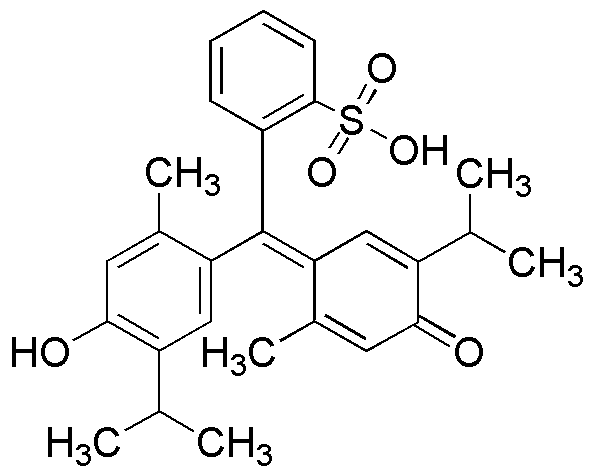Thymol blue is widely utilized in research focused on:
- pH Indicator: Commonly used in laboratories, it serves as a reliable pH indicator in titrations, helping researchers determine the acidity or alkalinity of solutions with clear color changes.
- Biological Research: In microbiology, it aids in assessing the growth of bacteria and fungi by indicating pH changes in culture media, thus providing insights into microbial metabolism.
- Analytical Chemistry: Employed in various analytical methods, it enhances the detection of specific compounds in complex mixtures, making it valuable for quality control in pharmaceuticals and food industries.
- Environmental Monitoring: Used in water testing, it helps in monitoring the pH levels of natural water bodies, which is crucial for maintaining aquatic ecosystems and ensuring safe water quality.
- Education: A staple in educational settings, it is often used in chemistry labs to teach students about acid-base reactions and the importance of pH in chemical processes.
General Information
Properties
Safety and Regulations
Applications
Thymol blue is widely utilized in research focused on:
- pH Indicator: Commonly used in laboratories, it serves as a reliable pH indicator in titrations, helping researchers determine the acidity or alkalinity of solutions with clear color changes.
- Biological Research: In microbiology, it aids in assessing the growth of bacteria and fungi by indicating pH changes in culture media, thus providing insights into microbial metabolism.
- Analytical Chemistry: Employed in various analytical methods, it enhances the detection of specific compounds in complex mixtures, making it valuable for quality control in pharmaceuticals and food industries.
- Environmental Monitoring: Used in water testing, it helps in monitoring the pH levels of natural water bodies, which is crucial for maintaining aquatic ecosystems and ensuring safe water quality.
- Education: A staple in educational settings, it is often used in chemistry labs to teach students about acid-base reactions and the importance of pH in chemical processes.
Documents
Safety Data Sheets (SDS)
The SDS provides comprehensive safety information on handling, storage, and disposal of the product.
Product Specification (PS)
The PS provides a comprehensive breakdown of the product’s properties, including chemical composition, physical state, purity, and storage requirements. It also details acceptable quality ranges and the product's intended applications.
Certificates of Analysis (COA)
Search for Certificates of Analysis (COA) by entering the products Lot Number. Lot and Batch Numbers can be found on a product’s label following the words ‘Lot’ or ‘Batch’.
*Catalog Number
*Lot Number
Certificates Of Origin (COO)
This COO confirms the country where the product was manufactured, and also details the materials and components used in it and whether it is derived from natural, synthetic, or other specific sources. This certificate may be required for customs, trade, and regulatory compliance.
*Catalog Number
*Lot Number
Safety Data Sheets (SDS)
The SDS provides comprehensive safety information on handling, storage, and disposal of the product.
DownloadProduct Specification (PS)
The PS provides a comprehensive breakdown of the product’s properties, including chemical composition, physical state, purity, and storage requirements. It also details acceptable quality ranges and the product's intended applications.
DownloadCertificates of Analysis (COA)
Search for Certificates of Analysis (COA) by entering the products Lot Number. Lot and Batch Numbers can be found on a product’s label following the words ‘Lot’ or ‘Batch’.
*Catalog Number
*Lot Number
Certificates Of Origin (COO)
This COO confirms the country where the product was manufactured, and also details the materials and components used in it and whether it is derived from natural, synthetic, or other specific sources. This certificate may be required for customs, trade, and regulatory compliance.


